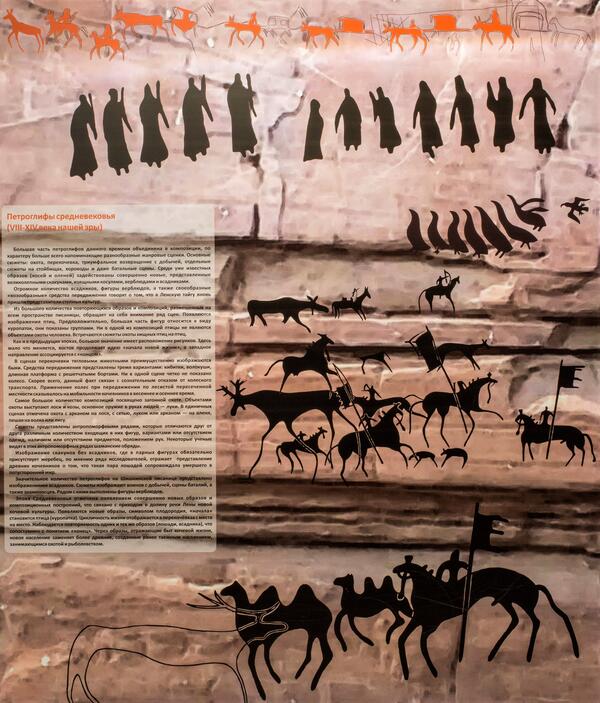The Shishkino rock paintings are a series of petroglyphs on the bank of the Lena River in the Kachugsky District of Irkutsk region. They are considered to be one of the most famous and largest monuments of rock art in Siberia. In total, more than 3,000 drawings were found on the surface of the rocks. The length of the area is 3.5 kilometers.
In the Irkutsk Museum of Local History one can see images of the Shishkino petroglyphs, which were copied by scientists and artists. After these drawings were published, they were printed on film and placed on tablets as part of the exhibition.
The petroglyphs were discovered in the early 18th century by a German scientist Gerhard Friedrich Miller. During an expedition to Siberia, he spent 10 days on the banks of the Lena River. Local residents told the researcher about the rock paintings, and he even sent an artist, Lurenius, to copy them, but Miller showed no serious interest in the find.
For the second time the Shishkino art drawings were discovered in 1929 by an archaeologist and academician from Irkutsk Aleksey Okladnikov. When he was a student, he was sent to the village of Shishkino. There, the young researcher learned from the locals about the ancient drawings on the rocks. Okladnikov studied and described the Petroglyphs for many years.
The earliest surviving drawings scientist dated to the late Neolithic era (4200-5200 years ago), and the latest to 16-19 century AD.
Usually, the word ‘petroglyphs’ means drawings depicted on rocks. At Shishkino they are performed in different ways: some were rubbed, embossed or scratched into the rock, while some silhouettes were dyed with ochre. Figures of people and animals were depicted next to the silhouettes of mythical animals and scenes from everyday and domestic life. The significance of these old drawings is still being examined by scientists and is a subject of much debate.
In 1948, thanks to the efforts of archaeologists Aleksey Okladnikov and Pavel Khoroshikh, the site was placed on the regional register of cultural heritage and it came under state protection. However, in the 20th and 21st centuries, the archaeological site came under threat of destruction: the rock itself was decaying over the years, besides, some people left their autographs next to the drawings. Then it was decided to describe, copy and study the petroglyphs using new methods and technologies.
In the Irkutsk Museum of Local History one can see images of the Shishkino petroglyphs, which were copied by scientists and artists. After these drawings were published, they were printed on film and placed on tablets as part of the exhibition.
The petroglyphs were discovered in the early 18th century by a German scientist Gerhard Friedrich Miller. During an expedition to Siberia, he spent 10 days on the banks of the Lena River. Local residents told the researcher about the rock paintings, and he even sent an artist, Lurenius, to copy them, but Miller showed no serious interest in the find.
For the second time the Shishkino art drawings were discovered in 1929 by an archaeologist and academician from Irkutsk Aleksey Okladnikov. When he was a student, he was sent to the village of Shishkino. There, the young researcher learned from the locals about the ancient drawings on the rocks. Okladnikov studied and described the Petroglyphs for many years.
The earliest surviving drawings scientist dated to the late Neolithic era (4200-5200 years ago), and the latest to 16-19 century AD.
Usually, the word ‘petroglyphs’ means drawings depicted on rocks. At Shishkino they are performed in different ways: some were rubbed, embossed or scratched into the rock, while some silhouettes were dyed with ochre. Figures of people and animals were depicted next to the silhouettes of mythical animals and scenes from everyday and domestic life. The significance of these old drawings is still being examined by scientists and is a subject of much debate.
In 1948, thanks to the efforts of archaeologists Aleksey Okladnikov and Pavel Khoroshikh, the site was placed on the regional register of cultural heritage and it came under state protection. However, in the 20th and 21st centuries, the archaeological site came under threat of destruction: the rock itself was decaying over the years, besides, some people left their autographs next to the drawings. Then it was decided to describe, copy and study the petroglyphs using new methods and technologies.



